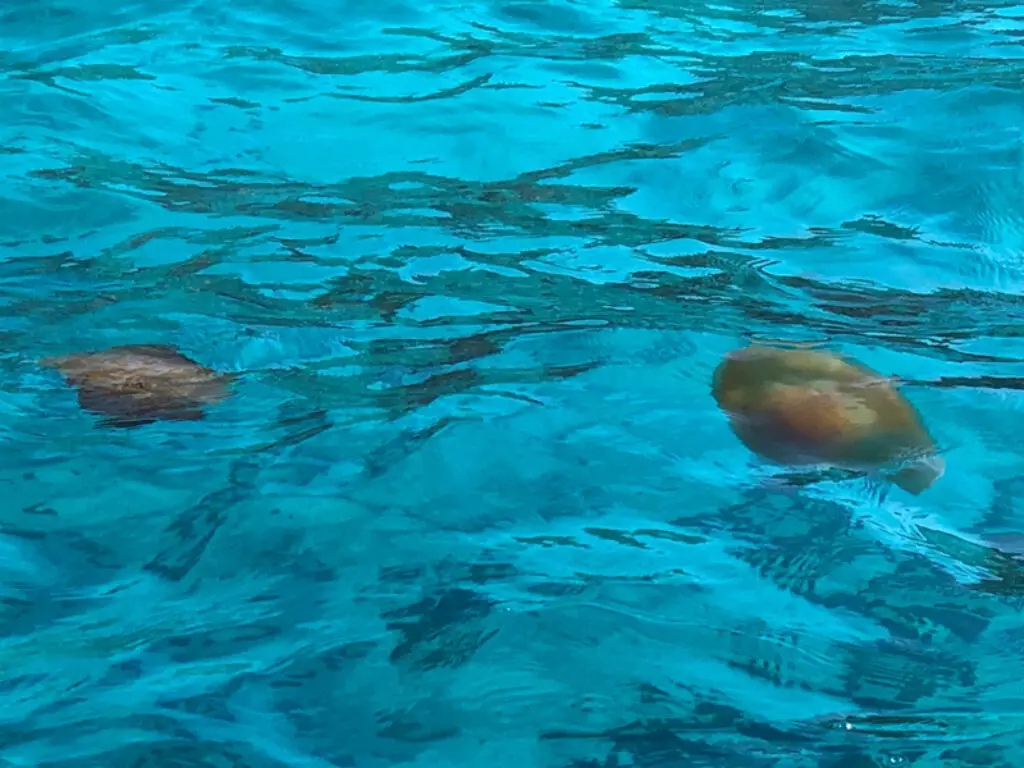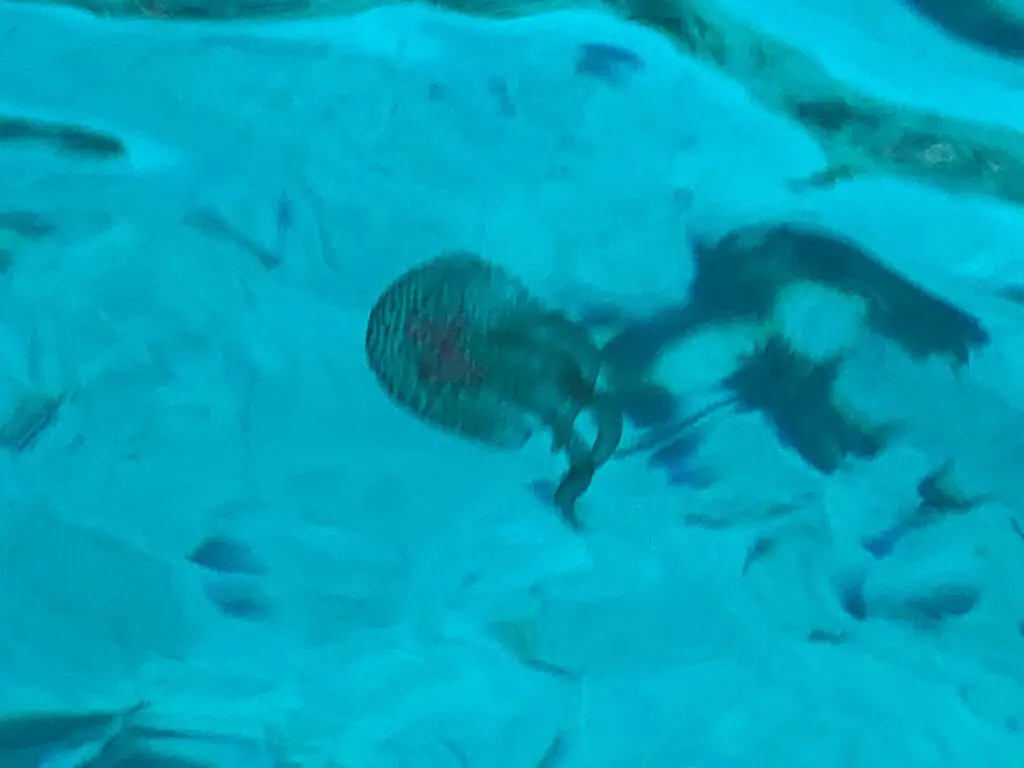Jellyfish in Sardinia | Info | Best Live Bays | Treatment
Sardinia offers an ideal setting for enjoying the sun and the sea. While visiting, you might come across jellyfish in Sardinia, but there’s no need to let that spoil your beach time. By staying well-informed and prepared, you can fully relish your beach experience with peace of mind.
There are several species of jellyfish that are common in Sardinia’s waters. Most of them are harmless or have mild stings, but there are a couple with more potent stings that can result in significant discomfort. Additionally, there is the rare and jellyfish-like Portuguese Man o’ War, which causes excruciating pain and can pose danger to humans.
Below, you’ll find useful information about the jellyfish to help you avoid them, details about different types of jellyfish to be cautious of, and tips on treating jellyfish and siphonophore stings. Armed with this knowledge, you can make the most of your time at the beach without undue worry.
Avoiding Jellyfish in Sardinia and Best Live Bays
Stay Away From Jellyfish
Fingers crossed you will not encounter any jellyfish on your trip to Sardinia. Most beachgoers will have the good fortune not to, but not all. If you do come across them, it’s usually just one or a few scattered in the water.
Being aware of your surroundings is essential. If you spot a jellyfish nearby, simply move away to avoid getting stung. Keeping an eye on other beachgoers can also help you determine if there are jellyfish in the area.
Best Live Bays
It helps if you could know where to go beforehand so that you can avoid jellyfish in Sardinia altogether. Unfortunately there aren’t great online tools showing the best live bays to avoid jellyfish.
There is Meduseo, a live map displaying jellyfish distribution in a couple of areas in Sardinia. You could potentially make assumptions on the jellyfish presence in nearby bays close to the marked areas to figure out if they also have jellyfish. However this isn’t always going to work and you may want to go to a beach that’s much further off.
What you could do is check Meduseo to see if there are any jellyfish first in those 2 areas. If there are, you can then have a look at WindFinder, which shows the wind direction and waves direction. Usually waves will eventually move in the same direction as the wind, and since jellyfish are passive drifters they will get carried along.
For example, if the wind and sea currents are westly, then you should choose a beach on the east side or that is sheltered from the westerly waves. In this way you can avoid jellyfish as much as possible.
However this isn’t a guaranteed method, because wind and sea currents can change direction during the day. So while your mornings might be jellyfish-free, they could appear later in the afternoon.
Be Prepared
Being prepared is wise and carrying After Bite with you is a good precaution. After Bite is effective for treating common jellyfish stings and comes in a small, portable bottle for easy carrying. It’s a popular addition to any first aid kit and provides relief from jellyfish stings and insect bites.
Types of Jellyfish
Some jellyfish species found in the waters around Sardinia, include:
Moon Jellyfish (Aurelia Aurita)
Appearance: Aurelia Aurita is a translucent jellyfish with a saucer-shaped bell, often resembling a moon, from which it gets its common name. It has short, fine tentacles that hang down from the bell’s edge.
Sting Potency: The sting of Aurelia Aurita is relatively mild and is not typically dangerous to humans. Most people may only experience a slight irritation or mild rash if stung.
Fried Egg Jellyfish (Cotylorhiza Tuberculata)

Appearance: Cotylorhiza Tuberculata has a distinctive appearance, with a flat, disc-shaped bell that resembles a fried egg. It can vary in colour from white to yellow or brown, with a frilly edge and short, stubby tentacles.
Sting Potency: Cotylorhiza Tuberculata is generally considered to have a mild sting that is not harmful to humans. It is one of the few jellyfish species that is considered relatively safe to touch.
Barrel Jellyfish (Rhizostoma Pulmo)
Appearance: Rhizostoma Pulmo is a large jellyfish with a round, barrel-shaped bell that can reach up to one meter in diameter. It is usually pale pink or bluish with a smooth surface and frilly oral arms.
Sting Potency: The sting of Rhizostoma Pulmo is usually mild and not considered dangerous to humans. However, it’s always best to avoid contact to prevent any potential discomfort.
Compass Jellyfish (Chrysaora Hysoscella)
Appearance: Chrysaora Hysoscella has a distinctive brown or yellowish V-shaped pattern on its bell, resembling a compass, which gives it its common name. It has long, slender tentacles with nematocysts.
Sting Potency: The sting of Chrysaora Hysoscella can be painful but is generally not life-threatening. Most stings result in localised irritation and discomfort.
Mauve Stinger (Pelagia Noctiluca)

Appearance: The Mauve Stinger is a small to medium-sized jellyfish with a bell-shaped body that is typically pink, mauve, or purple in colour. It has long, slender tentacles covered in nematocysts (stinging cells).
Sting Potency: The sting of Pelagia Noctiluca can be quite painful and irritating to humans. While it is generally not life-threatening, some individuals may experience more severe reactions, especially if they are sensitive or allergic to jellyfish stings.
Potentially Deadly: The Portuguese Man o’War
The Portuguese Man o’ War is actually a siphonophore and not a jellyfish. It is made up of many different organisms that looks and behaves like a jellyfish.
It is rather stunning with a floating, gas-filled bladder that is typically blue or purple. The iridescence of the bladder adds to its captivating beauty, while long, trailing tentacles, usually in shades of blue, pink, or purple, extend from it.
However it is crucial to be cautious and avoid getting stung by the Portuguese Man o’ War. Their sting is excruciatingly painful and venomous, and potent enough to pose serious risk to humans.
The Portuguese Man o’ War is the only species that has caused rare jellyfish deaths in the Mediterranean. It is not native to the Mediterranean Sea and gains entry through the Strait of Gibraltar.
Fortunately, there aren’t many of them that come through into the Mediterranean every year and are generally rare. However people are seeing Portuguese Man o’ War more often in the region.
In fact in 2010 the first case of a Portuguese Man o’ War death in the Mediterranean occurred in Sardinia. The poor 69 year old woman that got stung, had a severe adverse reaction and ended up dying on the beach.
Fortunately, most Portuguese Man o’ War stings, though painful, do not prove fatal. The stings typically leave whip-like lash marks on the skin, leading to irritation and pain.
If you are stung or spot one of these creatures, please advise the life guard on duty immediately and call the emergency line on 112.
Treating Jellyfish Stings
In most cases of jellyfish stings in Sardinia, you can easily administer treatment yourself. Here’s a 3-step process for treating jellyfish stings from the most common species:
- Rinse the affected area with seawater for 5-10 minutes.
- Use a straight-edged item, such as a credit card, to gently remove the stinging cells, even if they are not visible.
- Apply vinegar, alcohol, or After Bite. After Bite is particularly convenient to have on hand since it comes in a small, portable bottle that you can carry anywhere.
You may experience discomfort and irritation, but these symptoms should subside over time. Milder stings will usually clear up more quickly than those from the Mauve Stinger.
However, if you experience a more severe reaction or if the affected area does not improve within a couple of days, it is advisable to seek advice from a doctor.
Treating Siphonophore Stings
Siphonophores are a different kettle of fish that require a different approach for treating their stings. Although they are generally not deadly, some people have had severe reactions to their stings.
If you get stung by a siphonophore, follow these steps:
- Notify the lifeguard and call the emergency line at 112, so they can provide guidance.
- Apply seawater to the affected area. However, avoid using rubbing alcohol, freshwater, or ice, as they may release toxins from the tentacles. Do not rub the area
- Apply a hot pack to the area.
You should monitor your reaction to the sting over time. If it does not subside or gets worse you should seek medical advice again.
Related Articles

Is Sardinia Expensive? A Detailed Price Guide for Tourists

5 Areas Where to Stay in Sardinia: Families, History, Outdoors

5 Days in Sardinia: 3 Itineraries to Consider